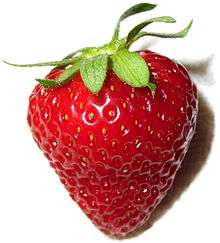George M. Darrow
George McMillan Darrow (1889–1983) was the foremost American authority on strawberries. He worked for the United States Department of Agriculture (USDA-ARS) for forty-six years (1911-1957) as a pomologist and small fruits breeder, and authored numerous papers on horticulture.
Life and career
Darrow was born in Springfield, Vermont on February 2, 1889. He graduated from nearby Chester High School in 1906, and in 1910 from Middlebury College with a BA. He went on to Cornell University, obtaining an MA in horticulture in 1911. During 1913-1917 Darrow joined with future U.S. Senator George Aiken in "Darrow and Aiken," a fruit growing enterprise in Putney, Vermont. By 1917, however, he was committed to full-time work with the U.S. Department of Agriculture. In 1927 he obtained a Ph.D in Plant Physiology from Johns Hopkins University in Baltimore. In his career with the USDA-Agricultural Research Service from 1911-1957 Darrow authored over 230 published works. The bulk of his career was spent in Maryland (Glenn Dale and later Beltsville). However, in the late 1920s-early 1930s he initiated small fruit breeding programs in Oregon for the USDA. He is predominantly known for strawberry breeding and research, but he worked with all small fruits, including blackberries, raspberries, and blueberries. His personal hobby and passion was breeding daylilies.
In the late 1920s, Darrow began tracking down reports of a large, reddish-purple berry that had been grown on the northern California farm of a man named Rudolph Boysen.[1] He enlisted the help of Walter Knott, a Southern California farmer who was known as a berry expert. Knott had never heard of the new berry, but he agreed to help Darrow in his search. Darrow and Knott learned that Boysen had abandoned his growing experiments several years earlier and sold his farm. Undaunted, Darrow and Knott headed out to Boysen's old farm, on which they found several frail vines surviving in a field choked with weeds. They transplanted the vines to Knott's farm in Buena Park, California, where he nurtured them back to fruit-bearing health, making Knott the first to commercially cultivate "boysenberries".
In 1956-1957 Darrow surveyed the native strawberries of Chile and collected germplasm in Andean South America. After retiring in 1957 Darrow wrote his classic book, "The Strawberry: History, Breeding and Physiology," published in 1966. The three chapters on strawberry history were written by D. Vivian Lee. It is available online via the National Agricultural Library.[2] He died in 1983 in Maryland.
References
- ↑ "Oregon Boysenberries". Retrieved 2008-09-13.
- ↑ Darrow, George M. (1966). "The Strawberry: History, Breeding and Physiology." National Agricultural Library. Retrieved December 5, 2012.
External links
- "George McMillan Darrow Papers" (2001). National Agricultural Library. Special Collections. Retrieved December 5, 2012.
